KDE Desktop on PCLinuxOS
Published by the United Nations Development Programme's Asia-Pacific Development Information Programme (UNDP-APDIP)
Kuala Lumpur, Malaysia
Web: http://www.apdip.net/
Email: info@apdip.net
© UNDP-APDIP 2004
The material in this guide may be reproduced, republished and incorporated into further works provided acknowledgment is given to UNDP-APDIP.
This work is licensed under the Creative Commons Attribution License. To view a copy of this license, visit
http://creativecommons.org/licenses/by/2.0/ or send a letter to Creative Commons, 559 Nathan Abbott Way, Stanford, California 94305, USA.
This guide has been modified by Papawoob to reflect the Linux distribution of PCLinuxOS 2007.
Chapter 2 - Part 2
Welcome back to our continuing journey into the mysteries of the Kde Desktop Environment. This part is mostly about using all of the available eyecandy to make your desktop look and function exactly the way you want it to. So lets jump right in!
Desktop Themes
The desktop theme specifies the visual appearance of the panels, applets, and windows by combining settings for the background, colors, window style, icons, fonts, and screen saver. The desktop theme may also specify the appearance of interface items in applications. For example, the theme affects the appearance of buttons, scrollbars, check boxes, and so on in the applications.
The theme used by the Desktop can be changed by executing the Theme manager from the Menu.
"Menu -> System -> Configuration -> KDE -> System Administration -> Theme Manager"
On open, a theme selector dialog window is displayed. The screen-shot below shows a sample of some of the available themes. Note that the actual themes available may vary from system to system.

Fig. Theme Manager
As you can see in the Theme Manager screen-shot, you will find a list of available themes in the upper left hand corner. To choose a theme, just click on one and then click on the "Install New Theme" button. If the new theme does not suit your fancy then try another, and another, and another, until you find one that you like.
Now, it is possible that you do not find any of the default themes to your liking. Have no fear! The "Install new themes..." link in the upper right hand corner will transport you to http://www.kde-look.org/ where you will find literally hundreds of other themes. It will also be your source for just about any form of eye-candy that you will ever need for your Kde desktop.
Before we move on, make note of the six tabs that are located along the bottom of the Theme Manager window. We previously covered Backgrounds and Screen savers in Part 1. Clicking on one of these tabs will bring you to windows that you are already familiar with. The other four tabs (Fonts, Style, Icons, and Colors) are what we will be covering in the following paragraphs.
Default Fonts
The default fonts used to display applications and the desktop background can be changed by executing the Fonts application from the KDE Theme Manager or by using the menu.
"Menu -> System -> Configuration -> KDE -> Fonts"
Selector dialogs for the application, window title, dialog and terminal fonts are displayed as shown below:
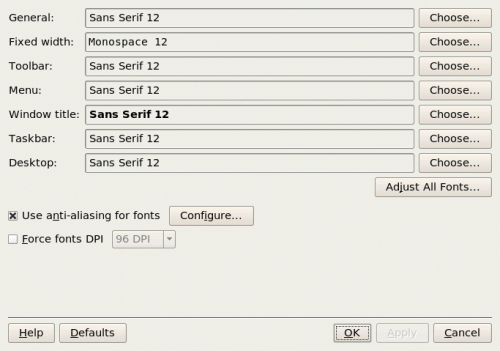
Fig. Fonts Window
To change the font for each category of usage, click on the "Choose" button to the right of the corresponding listing the font. This will open a new dialog window where you may choose from different fonts and see what each looks like before deciding which one you want to keep. A selection example is shown in the “Requested Font window" below:
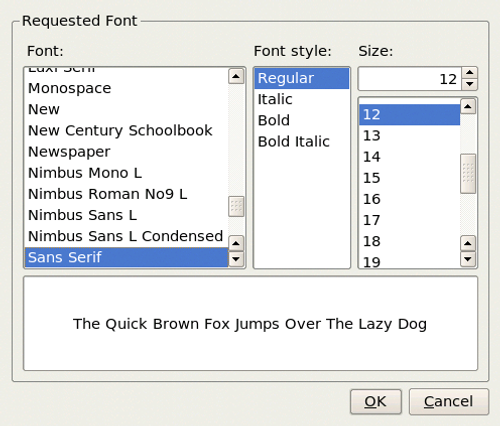
Fig. Selecting New Fonts
As you make your choices of Font, Font style, and size, you will see the effects of each of your choices in the display box at the bottom of the window. Once you have found the right combination, click on the "OK" button.
Style
The Style tool is used to customize the appearance of menus, menubars, and toolbars. Again this can be run from the KDE Theme Manager or by using the menu.
"Menu -> System -> Configuration -> KDE -> Style"
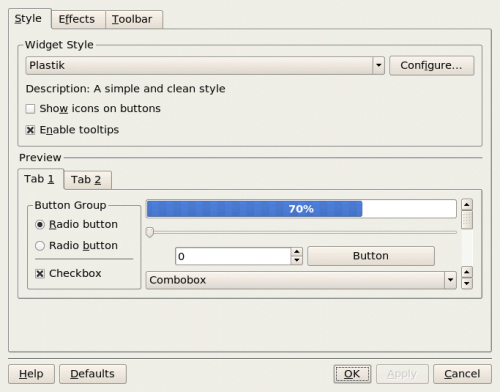
Fig. Style Dialog Window
As you can see in the screenshot above, the Style window provides three tabs, Style, Effects, and Toolbar. The greatest effect created by using these three tabs will be with the "Widget Style" part of this window. Experiment with the settings to determine the ones you prefer.
Icons
The Icon theme window offers many choices as shown below:
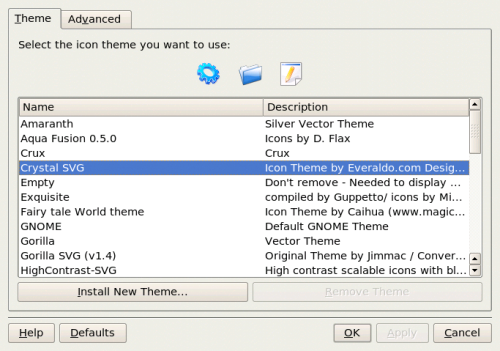
Fig. Icon Theme Window
Go ahead and choose an icon theme by clicking on any of the listed themes. Pay attention to the three icons located above your theme list. As you click on each theme you will notice these icons change to show you how they will look on your desktop. When you find one theme that you like, click on the "Install New Theme" button.
The "Advanced" tab offers you with the ability to set effects for your Default, Active, and Disabled icons. You may also choose to animate your icons and change the pixel size. Next we move onto choosing Colors.
Colors
The Colors Dialog window provides many choices of color themes to choose from.
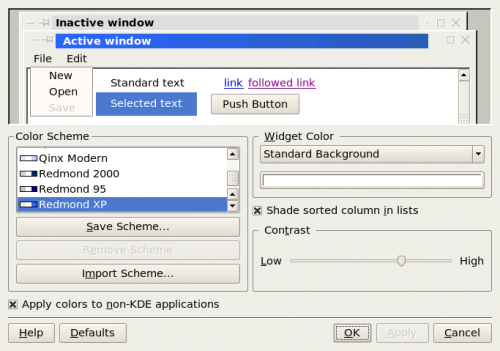
Fig. Colors Dialog Window
With the above “Active” window, you can again see the effects of your choices at the top of the window. When you find the one you like, click on the "Save Scheme..." button.
Exercises
Experiment with each of the following desktop preferences:
- Themes
- Fonts
- Styles
- Icons
- Colors
Using the Desktop
The Desktop provides a useful metaphor for a modern office work environment. On the Desktop we place the icons representing the application that we want to run frequently. Clicking on the icon allows the application to be easily started or launched. Other information and data that we need to reference can easily be located on the Desktop as well.
Running Applications
Applications that we can run from the Desktop are to be found either from the Main Menu (and sub-menus therein), or as icons on the Panel and on the Desktop itself.
To run an application from the Main Menu, open up the menu (or sub-menu) and click on the application listed in the menu bar.
To run an application from the Panel, click once on the icon representing the application.
To run an application from the Desktop itself, double-click on the icon representing the application.
Sometimes it is more handy to have an application as an icon on the Panel or Desktop where you can launch it more easily by just clicking on it. To transfer the application to the Desktop from the Main Menu. To achieve this, open the Main Menu or one within several sub-menus, select the application item listed in it by clicking on the icon with the right mouse button. Click on the "Add Item to Main Panel" to transfer a copy of the application icon to the Panel.
To make a link of the application on the Desktop, click with the right mouse button, and select "Add Item to Desktop" and the application icon will be placed on the the Desktop.
To delete an application icon from the Panel, right-click on it and select the "Remove <application> Button" option.
To delete an application icon from the Desktop, right-click on it and select the "Move to Trash" option.
The Panel
The Panel houses many useful utilities called applets. Applets are small applications that run from the Panel. As discussed in Chapter One, by default, the taskbar and the workspace switcher applets are placed and run from the Panel. Other useful applets that may be placed on the Panel include:
- clock
- dictionary
- volume control
- preferred applications
Placing an Applet on the Panel
To place an applet on the Panel, move the mouse over to an empty space on the Panel and click the right mouse button. Select the item "Add Applet to Panel" and from the sub-menu select the applet to place on the Panel. For example, to place the "dictionary" applet on the Panel, select:
"Add Applet to Panel -> Dictionary"
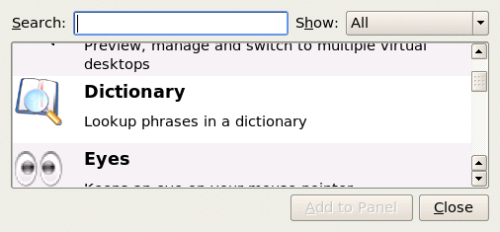
Fig. Add Applet
To prevent accidental removal of an applet, you can lock the Panel by right-clicking on it and selecting "Lock Panels".
Removing an Applet from the Panel
To remove an applet, right-click on the applet icon and select the "Remove <application> Button" option. If the applet is locked, you will have to first unlock it by right-clicking on the icon and selecting "Unlock".
Configuring the Panel
To change the properties of the Panel, right-click on the Panel and select "Configure Panel".
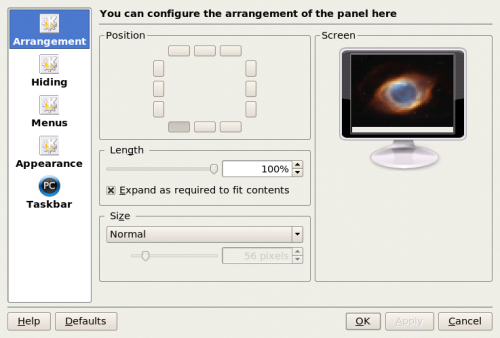
Fig. Configure Panel
- From the Arrangement properties tab you can change the position, length, and size of the Panel.
- From the Hiding properties tab, you can hide and (un)hide the Panel, as well as change how other windows interact with it.
- From the Menus properties tab, you can change the way the Main Menu displays its entries.
- From the Appearance properties tab, you can change the color of the Panel as well as its visual appearance.
- From the Taskbar properties tab, you can change the way the taskbar displays running programs in the Panel.
Launchers
Launchers allow the user a quick way to access specific resources on the system. For example, if a user often needs to access a specific file in one of the folders, he can create a launcher to run an application to open the file and this launcher can be placed on the Desktop. In this way the resource (the file) can be accessed very quickly by just double-clicking on it.
To create a launcher on the Desktop, right-click on an empty area on the Desktop and select the item "Create New." From the sub-menu, select "Link to Application". Enter the Name and the Command to run (in the box shown below) and if you want you can select an icon for it by clicking on the icon button.
You can find most of the commands you need by clicking on the "Browse..." button, use the "up" arrow to move up in the file structure to "/" and double-click on "/usr." Once that window opens you can double-click on either "/bin" or "/share" and choose the necessary command in most cases.
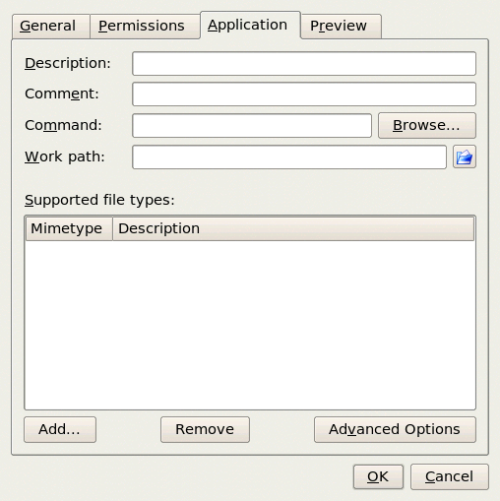
Fig. Creating a Launcher
Exercises
The Firefox web browser is a popular web browser application for Linux systems.
Locate the Firefox application in the Main Menu and place it on the Panel as well as the Desktop. Launch the Firefox application from:
- the Desktop
- the Main Menu
- the Panel
Configure the Panel so that it has the following properties:
- a background color of solid blue
- contains the Klipper and Storage Media (locked) applets
Create a launcher to run the text editor command "kate" from the Desktop. Use an appropriate icon for the text editor.
Setting the Date and Time
It is important that the date and time are set correctly in your system. This will make it easier to manage the system resources and files, and also aid in troubleshooting any problems. To set the date and time, run the Date & Time application tool from the Menu:
"Menu -> System -> Configuration -> KDE -> System Administration -> Date & Time"
Alternatively you can right-click on the clock (time) applet display on the Panel and choose "Adjust Date & Time".
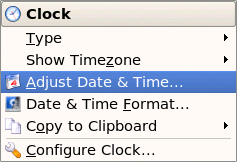
Fig. Right Click Clock Menu
A dialog box asking for the root password will appear if you are not logged in as root. Because the system date and time are important system parameters only the system administrator, or root, is allowed to do modify them. After entering the correct root password, you can change the date using the displayed calender, and the time. Select the Time Zone tab and check to verify that the timezone selected is correct. If not, correct it by selecting the appropriate timezone region. Usually the system uses the local time, so do not select the "Set date and time automatically" check-box.
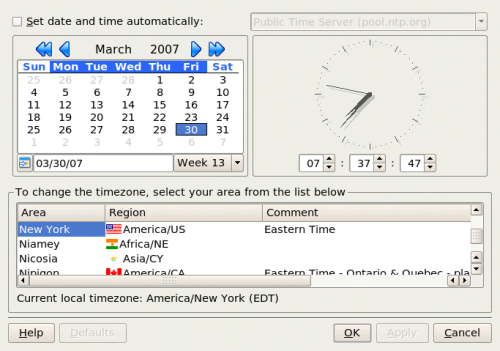
Fig. Setting the Date and Time
Click on the Apply button after all is done to establish the new date and time. You can check for the new date and time by resting your mouse over the clock (time) applet display on the Panel at the bottom of the screen. If the time is correct, click on the OK button.
You can also change the appearance of your clock by right-clicking on the clock (time) applet display on the Panel and choose "Type." This will give you four choices (Digital is the default), Plain, Analog, and Fuzzy.
Exercises
- Practice setting the date and time.
- Practice changing the appearance of the desktop clock
Once again we have reached the end of this installment. I hope you are looking forward to next months chapter in this ongoing how-to when we will be covering File System structure, permissions, and about everything you will ever need to do with files and folders. Y'all come back now, Y'hear!